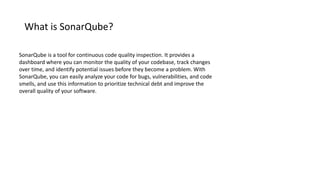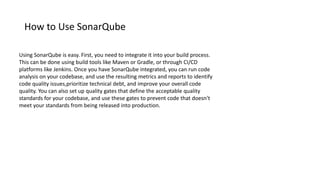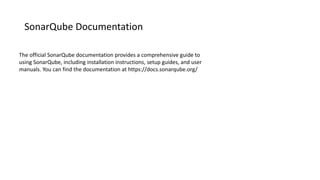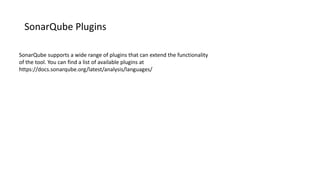SonarQube Presentation.pptx
- 1. SonarQube
- 2. Introduction to SonarQube SonarQube is a popular tool for code quality analysis and management, especially for web development projects. It offers several types of code analysis, such as static code analysis, code coverage analysis, and code duplication analysis, as well as quality gates that define a set of standards that code must meet before it is considered acceptable. In this presentation, we will discuss how web developers can use SonarQube to improve their code quality and streamline their workflow.
- 3. What is SonarQube? SonarQube is a tool for continuous code quality inspection. It provides a dashboard where you can monitor the quality of your codebase, track changes over time, and identify potential issues before they become a problem. With SonarQube, you can easily analyze your code for bugs, vulnerabilities, and code smells, and use this information to prioritize technical debt and improve the overall quality of your software.
- 4. How to Use SonarQube Using SonarQube is easy. First, you need to integrate it into your build process. This can be done using build tools like Maven or Gradle, or through CI/CD platforms like Jenkins. Once you have SonarQube integrated, you can run code analysis on your codebase, and use the resulting metrics and reports to identify code quality issues,prioritize technical debt, and improve your overall code quality. You can also set up quality gates that define the acceptable quality standards for your codebase, and use these gates to prevent code that doesn't meet your standards from being released into production.
- 5. Types of Analysis in SonarQube SonarQube provides several types of code analysis, including static code analysis, code coverage analysis, and code duplication analysis. Static code analysis checks the code for potential bugs, vulnerabilities, and code smells. Code coverage analysis measures how much of your code is covered by unit tests. Code duplication analysis identifies code that has been copied and pasted throughout your codebase, which can lead to maintenance issues and bugs.
- 6. Quality Gates in SonarQube Quality gates define a set of standards that your code must meet before it is considered acceptable. You can set up quality gates in SonarQube to ensure that your code meets specific quality requirements. For example, you can set up a quality gate that requires all unit tests to pass, that the code coverage is above a certain percentage, and that there are no critical security issues present in the code.
- 7. Benefits of Using SonarQube Using SonarQube can provide several benefits for web developers. By identifying and fixing code quality issues early, you can save time and effort in the long run. SonarQube can also help you prioritize technical debt and focus on the most critical issues first. Additionally, setting up quality gates can help you ensure that your code meets specific quality standards, which can improve the overall quality of your software and reduce the risk of bugs and security issues.
- 8. Conclusion In summary, SonarQube is a powerful tool for web developers that can help identify code quality issues, prioritize technical debt, and improve the overall quality of your codebase. By setting up quality gates, you can ensure that your code meets specific quality standards, and by using the different types of analysis available in SonarQube, you can gain insight into different aspects of your code. We hope this presentation has been informative and helpful in introducing you to SonarQube.
- 9. References Here are some resources where you can learn more about SonarQube:
- 10. SonarQube Documentation The official SonarQube documentation provides a comprehensive guide to using SonarQube, including installation instructions, setup guides, and user manuals. You can find the documentation at https://docs.sonarqube.org/
- 11. SonarQube Community The SonarQube community provides a forum where you can ask questions, share ideas, and get help with using SonarQube. You can find the community at https://community.sonarsource.com/
- 12. SonarQube Plugins SonarQube supports a wide range of plugins that can extend the functionality of the tool. You can find a list of available plugins at https://docs.sonarqube.org/latest/analysis/languages/
- 13. Thank You! Thank you for taking the time to learn about SonarQube!













